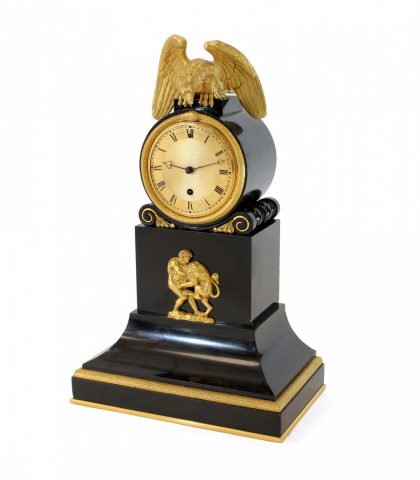A serpentine marble mantel clock by Benjamin Vulliamy, a highly esteemed clockmaker who was appointed Royal Clockmaker to George III. Several Vulliamy clocks form part of today’s Royal Collection.
The drum-head case is of small proportions. The movement is supported on a pedestal base with a pair of volutes and with a winged eagle surmount.
The gilt dial is signed VULLIAMY LONDON, within Vulliamy’s signature entwined serpent bezel and with fine steel heart hands, Roman chapter ring and an engine turned centre. The dial is numbered on the back with the serial number, 718.
The single fusee movement is signed to the backplate VULLIAMY, LONDON No. 718. It has an anchor escapement, rise and fall regulation and a flattened steel rod pendulum, the brass bob numbered to the movement, 718.
Also with a numbered double ended winding key.
The serial number dates this clock to 1819/20. This style of clock was popular for Vulliamy from 1810-1820.
Unfortunately the archive records of the Vulliamy family business held by the British Horological Institute contain two volumes relating to the clocks made by the firm: Volume 1, from March 1797 to April 1809, detailing clock numbers 296-469; and Volume 2, from May 1820 to May 1831, clock numbers 746-1067. This clock falls between the two volumes, and so details of the first purchaser are not known.
Height: 30cms
Width: 12.5cms
Depth: 9cms
Overhauled and guaranteed for 3 years.
Benjamin Vulliamy, son of Justin Vulliamy, the founder of this eminent family of clockmakers, was born in 1747. He was admitted to the Freedom of the Clockmakers’ Company 1781-1820. His son, Benjamin Lewis Vulliamy (born 1780) was free of the Clockmakers’ Company 1809-1854, when he died. He was the last Vulliamy to dedicate himself to the family clockmaking business, and was proud to hold the Royal Warrant until his death.
Also available:
Ref: Vul
Make an enquiry




